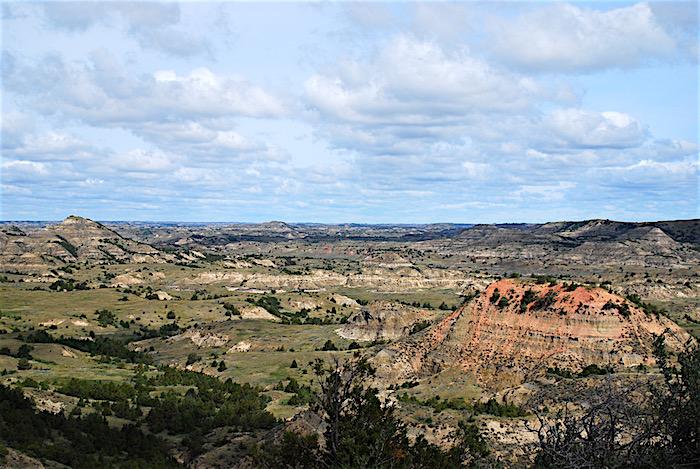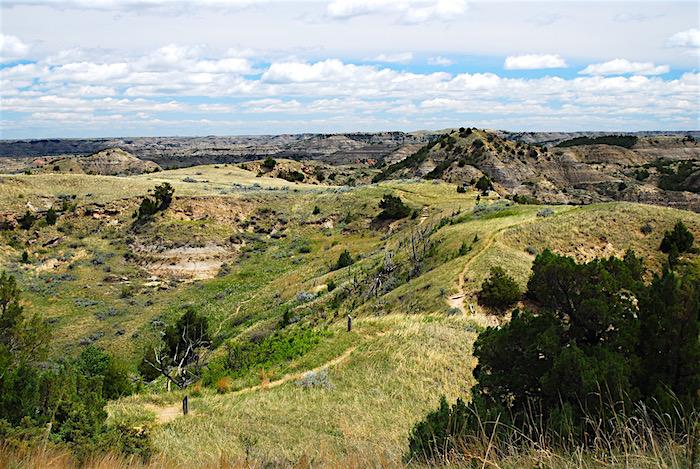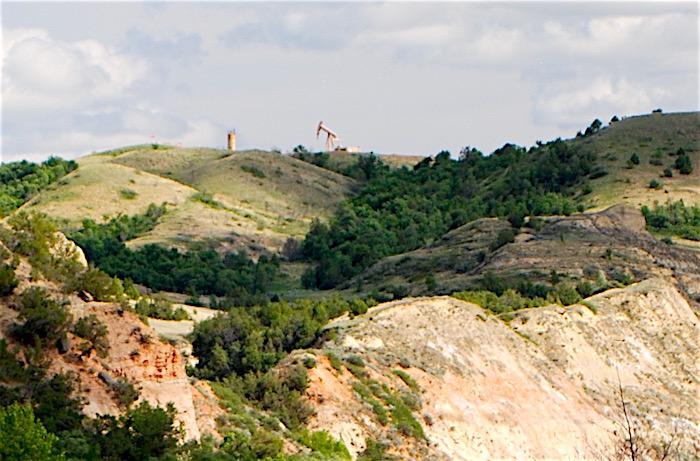
An oil refinery proposed just three miles from the South Unit of Theodore Roosevelt National Park (above) has raised concerns of how it might impact the park's air quality/Kurt Repanshek
While falling oil prices have slowed production from North Dakota's oil and natural gas fields, a company sees that lull as the perfect opportunity to build a crude oil refinery in the state.
However, its proposed location just three miles from Theodore Roosevelt National Park has raised concerns from the National Park Service and conservation groups about how it will impact the park.
At Meridian Energy Group, Inc., the California company behind the $850 million refinery that could process 55,000 barrels of crude a day at full capacity, officials claim their proposed Davis Refinery would be "the cleanest plant ever built."
Others think it's a plant that should never be built in its proposed location.
“They shouldn’t be putting an industrial park next to a national park," Valerie Naylor, the park's former superintendent, said Friday during a phone call. "If this was being proposed within three miles of Yellowstone, Glacicer, Yosemite, or even Mount Rushmore, there would be a huge national outcry. I don’t know why there shouldn’t be a similar outcry about Theodore Roosevelt."
Targeted for a 620-acre swath of farmland between Belfield and Fryburg just east of Theodore Roosevelt, the refinery project is just the latest industrial development pressing in on the 70,447-acre national park. The U.S. Forest Service last year gave the OK for a 25-acre gravel pit across the Little Missouri River from Theodore Roosevelt's historic Elkhorn Ranch and roughly 25 miles from the core of the park's South Unit, while oil pumps dot the landscape in just about every direction. From Buck Hill in the park's South District, gas flares from fracking operations outside the park stand out at night.
The park, of course, was named after Theodore Roosevelt, who came to this landscape as a young man and discovered his conservation bent. The Elkhorn Ranch was where he recovered from the deaths of his wife, Alice, two days after giving birth to their daughter, and his mother on the same day, Valentine's Day 1884. The ranch setting remains bucolic today. While the ranch house is gone, there still stand some of the cottonwood trees that shaded the house and the porch from which the young Roosevelt would escape the heat with a book or simply to rock in his chair while taking in the Little Missouri and the badlands that it carved into the landscape.
Back in 2011, the National Trust for Historic Preservation, citing the gravel pit, named the ranch as one of its 11 most-endangered historic sites in the country. The pit is a byproduct of the oil boom, as it is a source for stone needed for the drill pads rising around northwestern North Dakota. Now, if plans to construct the oil refinery come to fruition, Theodore Roosevelt National Park might claim the distinction of being rimmed by more energy-related developments than any other park in the National Park System.
Oil refineries aren't often built in the United States. Currently, according to the U.S. Energy Information Administration, there are just 137 active refineries. Since the turn of the century, just three refineries have been built, and since 1985 just eight refineries came on line, the agency's records show. Just one of those eight, the Petro Star refinery in Valdez, Alaska, produces as much as 55,000 barrels per day, or as much as the Davis Refinery is designed to produce.
As proposed, the Davis Refinery would produce "(R)efined products include gasoline, diesel, jet fuel, heating oil, as well as lesser-known products such as lubricants, asphalt base, ethane for plastics, waxes and other specialty chemicals. The initial phase of the Refinery will focus on the production of jet fuel, diesel fuel and other distillate products, primarily for local markets."

Park Superintendent Wendy Ross says the refinery, if built in its current proposed location, would be visible from the Buck Hill Trail in the South Unit/Kurt Repanshek
The proposed location is adjacent to a BNSF rail loading facility at Fryburg; the rail line actually runs through the refinery site. Oil and natural gas pipelines are close by, too, according to Meridian.
The property also is near the junction of Highway 85 and Interstate 94. Highway 85 is the main north-south arterial that tanker trucks can use to carry crude from the Bakken field to pipeline and rail terminals.
On their website company officials, noting that more than 95 percent of the daily production from the Bakken is taken out of state for processing, say building a refinery "in the heart of the Bakken will ensure a steady supply of below-market crude oil feedstock from production companies seeking transportation savings and a local market for refined fuels."
Beyond the proposed Davis Refinery, though, Meridian officials expect their plant would attract "compatible industrial process units," according to a zoning application they filed with Billings (North Dakota) County officials. "For example, Meridian has received inquiries from agricultural chemicals firms, brewing companies, and others interested in locating facilities nearby once the Project is in operation," the documents state.
The company produced a promotional video to explain its plans, but blocked public access after the Traveler story appeared.
Ms. Naylor shudders at the thought of such development so close to Theodore Roosevelt's South Unit.
“That industrial park will extend from Fryburg all the way to Belfield if that is the case," she said, referring to the company's expectations of additional buildout. "That would be a really big industrial area right next to the national park. That’s not acceptable.”
Not without irony, the industrial development, if it materializes, would welcome visitors to North Dakota's No. 1 tourist draw, the national park. This year the state's tourism campaign, starring actor Josh Duhamel, focuses heavily on Theodore Roosevelt National Park. And already this year visitation to the park is up more than a third, and related revenues are nearing $40 million annually.
Company officials were traveling Friday and not immediately available to discuss their project.
In their application to Billings County, they are seeking a zoning change to allow the refinery to be built on acreage currently zoned for agriculture. In addition, they want permission to begin site preparation this summer, before the requisite air quality permits for the entire project are issued, "so that the project does not lose this coming summer as part of the construction schedule for the project." According to Meridian, North Dakota officials said "grading and site construction" can begin before the permits are issued.
As planned, the refinery would be operational by 2018.
Beyond the physical siting of an industrial development so close to the park, opponents worry about its impact on air quality. Many national parks, Theodore Roosevelt included, carry a Class I airshed distinction, which requires the highest level of protection under the Clean Air Act. And according to the National Park Service, Theodore Roosevelt "has some of the best visibility and cleanest air measured among all national parks."
However, the agency has pointed out in the past that "(R)egional oil and gas development, as well as nearby mining operations, power generating facilities, and agriculture, contribute to the formation of ozone and haze, sulfur and nitrogen deposition, and deposition of toxic air contaminants (e.g. mercury) at Theodore Roosevelt NP."

Theodore Roosevelt National Park has seen much development on its borders in recent years. This well pump was visible from the historic Elkhorn Ranch/Kurt Repanshek
How the proposed refinery's contributions would affect that air quality is unknown at this stage. Park Service and state of North Dakota air quality officials say they'll conduct rigorous computer modeling to project what that impact might be. That process alone could take a year, they say.
"It’s a little soon to assert whether there will or will not be park impacts. But I can say with a facility of this size, this close to a national park, we’re really concerned," said Bart Melton, regional director of the National Park Conservation Association's Northern Rockies office. "There’s plenty of room in North Dakota for protecting the park and continuing to grow the economy in the Bakken, which, we’re not opposed to that growth. We just want to make sure that it occurs in a way that protects the park and builds the regional economy, too.”
Wendy Ross, Theodore Roosevelt's superintendent for less than a year, has been almost bowled over by the development ongoing around the park. And while the oil boom has slackened somewhat, she said Friday, that hasn't slowed everything down, citing the gravel pit, efforts to expand Highway 85 from a two-lane to four-lane stretch through the park's North Unit, and other infrastructure projects.
But the proposed refinery, she said, has moved to the top of list of projects that concern her.
“I don’t think anybody really realizes how big this is," said Superintendent Ross.
When the superintendent was asked, she couldn't point to another national park that has been faced by such developments closing in on so many sides.
"I really can’t. If you look down the list, I just haven’t seen anything like that," she said.
At the end of the day, said Ms. Naylor, siting a crude oil refinery next door to a national park is wrong.
“I think there are many, many issues, many questions that are unanswered," she said. "In reality, the biggest issue is this big industrial development shouldn’t be within three miles of one of our premier national parks.”



Comments
PS to my anon post above. Exxon's deferred taxes fell by $3billion in 2015 which means they actually paid $3 billion more than the $57 billion that hit their income statement. Once again Lee, rather than explaining in your own words why $57 billion in taxes on $16 billion of income is a subsididy you tried to link to some totally irrelevant article and came nowhere close to answering - because there is no valid answer.
Ach, ya. Just as I predicted. Another game of Dodge'em.
But you nailed it. There is no valid answer because so much is hidden from the public.
Ken Burns' America's Best Idea is on TV tonight. It's a story filled with examples of how powerful forces manage to keep secrets and use bullying tactics to avoid having to be accountable for their actions.
It's as true today as it was in the days of John Muir.
Lee, the only one playing dodge'em is you. You have been asked multiple times to explain how payng $57 billion ($60 bil) in taxes with $16 bil of after tax incomee is a subsidy and multiple times you have dodged the question responding with non-sequiturs and additional unsustantiated accusations. Just because you act blind doesn't mean things aren't clear to those that that know how to look.
Actually, the corporation both of you should be investigating is General Electric. They have paid absolutely no federal income taxes in umpteen years--all the while benefiting from green energy tax breaks. Nor does the story end there. Read on (below). I may have missed it, but has Senator Sanders mentioned GE? Or the president? Or Ms. Clinton? Of course not. Solar and wind are "in." Oil and coal are "out."
Who will pay the taxes? You will, and you always do. The price of the taxes is passed on in the product. What do the subsidies accomplish? They skew the market so that a questionable technology can still look "viable."
http://www.huffingtonpost.com/2014/04/01/ge-lobbying_n_5064783.html
Alfred - exactly. Now see if you can get Lee to understand that.
[addendum]. I looked at their financials back to 2010 and they in fact paid taxes every one of those years. Also, Al, why do you think they (their customers) should pay U S taxes on income they generate outside the US?
Holy Mackeral, Comrade --- of course I understand it. That's what I've been yowling about for years. Corruption and money and greed in all corners of American corporate and Congressional alleys.
We need to do away with ALL tax and legal (and illegal) loopholes for everyone. Level the playing field perhaps with a flat tax so that all of us share in equal percentages. All of these abuses have come about as a result of lobbying power, backroom deals and shady shenanigans between politicians and their special interest donors.
Solar and oil and coal and Walmart and GE and you and I and everyone else should be carrying our fair share of the burden to pay for the services and things we want.
But until the subsidies for oil and coal and other fossil fuels are turned off, and until environmental safeguards are enforced as they should be, those extractive industries should not be handed unfair advantage over alternative forms of energy production.
Unfair advantage? Paying $57 bil in taxes when you take home $16 bil Is an "unfair advantage". You have some strange concept of fairness. Can you explain that? Of couse not, all you have done is run from the question because you have nothing to support your accusations.
OK folks, this thread has run its life. We're closing comments.